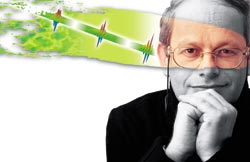Are you a journalist? Please sign up here for our press releases
Subscribe to our monthly newsletter:

Prof. Yaron Silberberg, the Head of the Weizmann Institute’s Physics of Complex Systems Department, has a vision: to take a penetrating look inside the most minuscule of objects.
He is attempting to do this by manipulating light.Silberberg is developing an imaging system that uses ultrashort pulses of laser light: each pulse lasts only a few femtoseconds (10-15 seconds). To illustrate, the ratio of ten femtoseconds to one minute is equivalent to the ratio of one minute to the age of the universe.

When such a brief laser pulse passes transparent material at very high intensities, a very small part of it is converted into light of a different color, harmoniously – meaning that the new light’s frequency (color) has increased precisely by a factor of either two or three.
For instance, if light that has a wavelength of 1.5 microns (infrared) passes through a transparent material at very high intensities, the new light waves that are generated have a frequency that is larger by a factor of three and thus are green.
Silberberg hopes that third-harmoniclight generation can be utilized to develop a new type of microscope. When the researchers direct very short pulses of laser at a lens, the intensity of light at the focal point is so high that enough third-harmonic light is generated to measure and characterize the material at that point.
The light can be focused into various depths to generate a three-dimensional image of an object, and since no prior treatment of the object is needed, this method can be used to image single cells or entire organisms.